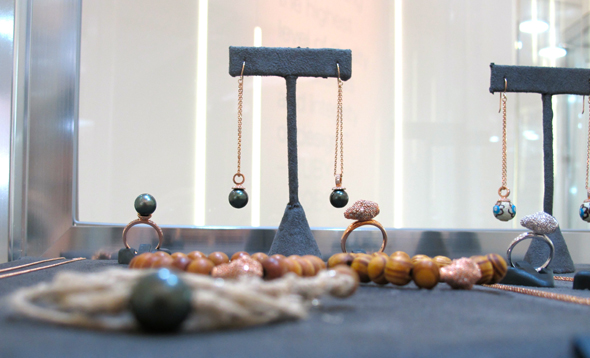
At 6 p.m., designer Yuvi Alpert is out for his first meal of the day, a gray cardigan wrapped around his neck like a scarf. Rushing through the crowded streets of the Garment District on a damp, cold evening, Alpert describes his beginnings as a designer.
“As a kid,” the thin blond Alpert says over the sounds of traffic, “I’d find something, like a rock on the beach, and I’d wear it for the next four years.”
These days, Alpert and his partner Danna Kobo create elaborate unisex jewelry for their line Ruby Kobo, ranging from hemp-wrapped diamonds to jewel-encrusted antler rings in their high-ceilinged, earthy studio in the heart of New York’s Garment District. Their luxurious digs are made possible by an innovative program that cultivates up and coming designers by subsidizing studio space and providing mentoring with well-known forces in the fashion world. It’s called the Council for Fashion Design Incubator, and it is composed of 11 designers, whose focuses range from high-end jewelry to menswear. Alpert and Kobo were chosen from hundreds of applicants to receive industry mentoring and a spacious studio for only $1,750 a month.
Lisa Smilor is the director of programs and operations for the CFDA Incubator, and says that when she saw Ruby Kobo’s application, she knew the line was “classically cool… they don’t settle for mediocrity. You just look at it and you want it.”
For Alpert, the experience of being in the incubator is more than just having a spacious place to work: it’s about the people. “Being in this community, knowing that people respect what we do… people believe in it.” At the midtown Italian restaurant Piccolo, between bites of fettuccini and email updates on his Blackberry, he says that on the Incubator’s third floor space, “you can just feel the creative energy – I love it.”
Established two years ago to support designers who show serious potential, the Incubator makes dreams come true. In addition to low-rent studio space, the designers get lectures from experienced fashion professionals and one-on-one mentoring from lawyers, marketing experts, buyers, and more experienced designers. In return, Incubator designers are expected to develop a business plan and give their work their all.
Smilor says the competition is stiff. “The caliber of people we work with is the top of the top. [The incubator designers] wouldn’t get this kind of time, let alone this kind of hand-holding, if it weren’t for the program.” She notes that Ruby Kobo has stood out to her since she saw Alpert and Kobo’s application. “You just looked and saw quality… this is something an editor wants to write about, that retailers want to buy.”
The pieces that Alpert and Kobo make are unisex, and range from simpler woven bracelets with fine metal plates on them, to elaborate statement pieces, such as a delicate skull charm on a black beaded chain and enormous statement rings of naturally shed antler coated in diamonds. The unique pieces range from $250 to $8,000 and can be found in retailers such as Bergdorf Men’s and Louis Boston.
This first group of designers in the Incubator have become major names on the New York fashion scene. Some, such as Prabal Gurung, have designed dresses seen on Michelle Obama and Reese Witherspoon. Many, including Gemma Redux, have been featured in magazines such as Style, Marie Claire, and Lucky. Ten of this year’s crop of 11 designers held events during Fashion Week last month.
Alpert and Kobo had a major show at Circa, the accessories salon at Mercedes Benz Fashion Week. They decorated a minimalist room in all white and glass, and featured tall glass cases of jewelry that ranged from black pearl drop earrings to woven rings. In the middle of the room sat three iPads on a thin table, each playing a video by a different cinematographer. The star of each video was Ruby Kobo’s jewelry.
For Alpert, this was a long way from his days of finding a rock and stringing it on a cord around his neck in his home city of Los Angeles, and later as a teenager, in Tel Aviv. After returning to the states to get his degree at the University of Miami, Alpert traveled to Nepal for inspiration. When he returned to take up residence in New York, he was broke. During the day he would design jewelry in his apartment, and at night he would work New York’s club and bar scene. It was around this time that he met Kobo through mutual friends, and the two began designing together. “It happened very organically,” says Alpert.
After they began designing together, the duo spent their non-design hours searching for email addresses and phone numbers of potential buyers and magazine editors. They designed pieces for interested buyers who contacted them, many of whom were in the fashion world. From there, their popularity grew, and they sold pieces to stores like Francino LA, Louis Boston, and Bergdorf Men’s. On the heels of this success, an editor at Vogue UK suggested they apply to the program in 2009. Smilor insists that “Hands down, they will be successful.” The incubator class starts the graduation process this month, at which point the designers will put their final touches on their business plans begin their move out process.
Alpert says he feels ready for success.
“I’ve had a great time, I love it. But the goal is to succeed. We will take it to the next level.”